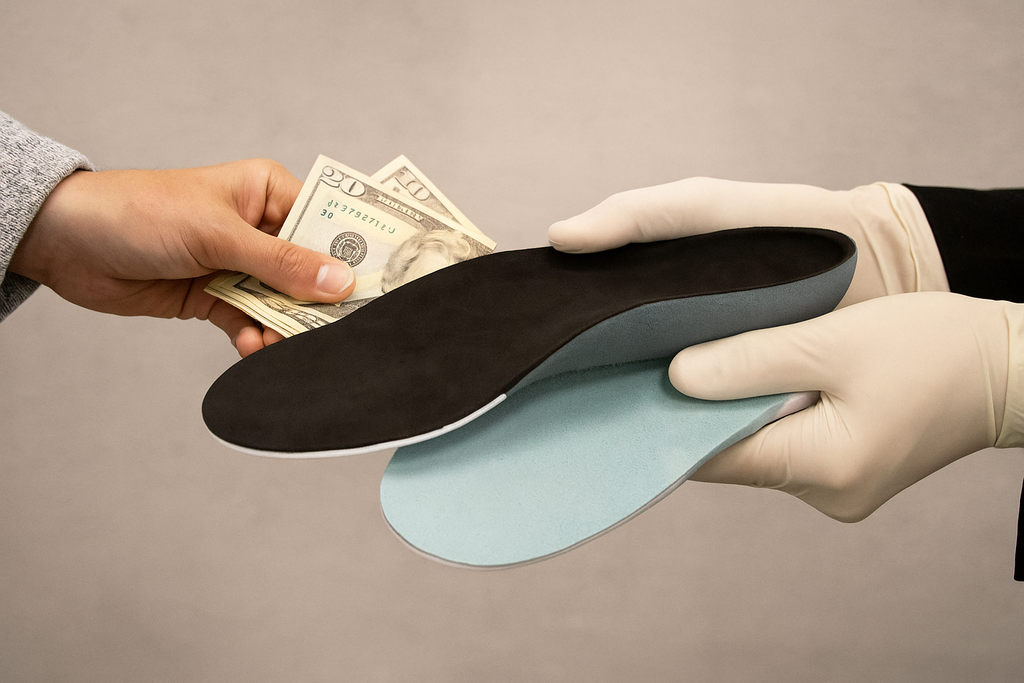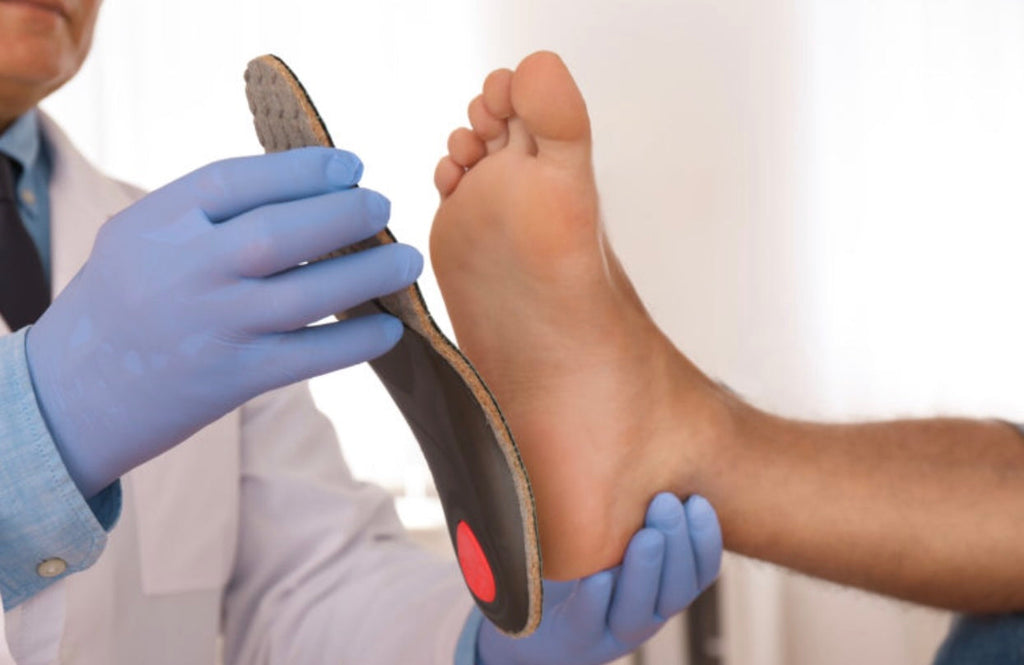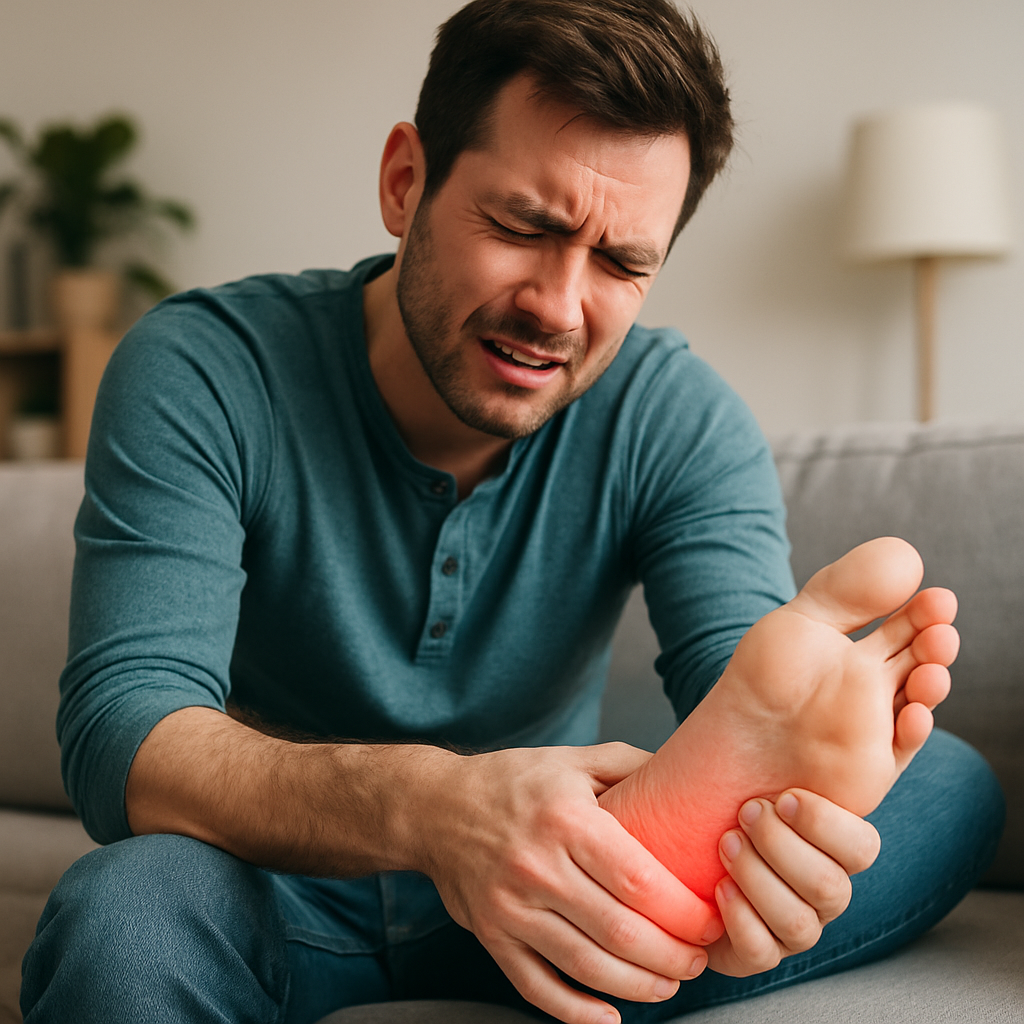Flat Feet Symptoms
Flat feet or fallen arches occur when the foot arch collapses to the ground. The initial flat feet symptoms tend to be mild, and you might shrug them off. However, this initial small foot discomfort will develop into more severe issues over time if you ignore the initial symptoms. This can lead to knee pain, hip pain, and back pain that can become debilitating.
Key Takeaways
- Flat feet describes a collapsed or absent arch, which negatively impacts how the foot functions.
- Initial symptoms are mild, including some fatigue and discomfort. These are often ignored until they become worse.
- Symptoms can spread to other parts of the kinetic chain—knees, hips, and lower back.
- The wear pattern on your footwear (wearing in the inner edges) can be an indication of flat feet.
- Seek professional help, if the pain persists or gets worse, your gait is beginning to alter, balance is affected, or normal activity is being impeded by the pain and discomfort.
This article presents the typical indicators of flat feet and explains how to identify these signs. Let’s explore the top 10 flat feet symptoms and how spotting them early can help you recover from flat feet.
What Is Flat Feet?
Flat feet sounds simple, right? But what does it really mean?
If you look at most feet from the side, there’s a gentle arch between the ball and the heel. That curve helps your body handle weight. It spreads pressure. It gives your step a bit of bounce.
With flat feet, that arch either never developed, or it collapsed somewhere along the way. So instead of curving, your foot rests flat against the ground. The entire sole touches the floor. That might not seem like a big deal, but it changes how your body moves.
Imagine a tiny bridge holding up a road. Now picture that bridge sinking into the river. Traffic still goes through, but it’s bumpier. There’s strain. That’s your foot with a fallen arch. It still works, but it’s struggling.
Some people are born with flat feet. Others develop them after years of wear and tear. Either way, the key is knowing what it feels like—and what to do next.
9 Well-known Flat Feet Symptoms
Knowing the top signs early can be extremely helpful for treating flat feet. When you identify the symptoms early, you can manage the flat-foot-related issues by making small adjustments like swapping shoes regularly, doing the much-needed exercises, or using support insoles that strengthen the foot muscles surrounding the arch. These symptoms are not always dramatic, but they show the pattern of how the body feels and reacts to foot movements, usually pointing to hidden foot structure concerns.
1. Arch Pain
If you feel pain in the middle of your foot, it could be because of prolonged standing and walking. If the gentle curve on your foot is missing and the whole sole touches the ground, it could be a clue. That missing curve is the arch. If it’s not there, the midfoot has to bear the extra pressure, leading to sore feet or tired feet.
At times, the pain starts slowly and gets worse by the end of the day. Because of the structure and design, shoes may feel tight. Cushioned inserts or arch support can be helpful in easing the pain.
2. Tired Legs After Mild Activity
People with flat feet experience leg fatigue at a lower intensity of physical activity than others do. The improper shock absorption of flat feet requires your leg muscles to work harder for movement.
As such short walks, together with standing for a period of time, can exhaust your legs, calves, or thighs. The tired sensation becomes noticeable after performing basic activities such as shopping or cleaning or walking between parking spaces.
3. Off-and-On Foot Pain
You may feel pain in different foot areas. One day, you feel pain in your heel, and the next day it could appear near your toes or under your arch. The pain usually increases after you stand or walk for a long time period. It may vanish when you rest or sit.
4. Uneven Shoe Wear
Flat feet can highly impact your walk. With time, the inner side of your shoe sole deteriorates more. Check your old shoes. If one side is thinner, this could be a hint. When you set your shoes on the floor, you may feel that they are leaning inward. This tilt clearly shows that your weight lands more on the inner side of your foot.
Poor distribution of weight like this can cause severe knee and hip pain. You may also observe smooth spots or holes near the toe side. Try using top-quality shoe insoles or changing shoes more often. If the uneven shoe wear stays, custom orthotics or arch support can assist in spreading the weight across your foot evenly.
5. Feet That Roll Inward When You Walk
Some people with flat feet notice their feet roll inward when walking. The condition is known as overpronation.
The condition occurs when the arch is either low or absent. The foot does not hit the ground flat because it rotates inward with each movement.
The use of supportive shoes together with arch inserts helps your feet to achieve better landing alignment. The use of this method helps decrease strain while improving walking comfort.
6. Sore Ankles and Swelling
Flat feet can make your ankles sore. This happens when your foot rolls inward and puts pressure on the tendons around the ankle. The more you stand, the worse it gets.
You might also see a little swelling. It can look puffy around the ankle bone, especially after a busy day.
Supportive shoes or inserts can help take the pressure off. Rest, ice, and light movement may ease the pain too. If swelling keeps coming back, it’s worth looking at how your feet move.
7. Knee and Hip Discomfort
Flat feet can throw off how your whole body moves. When the arch flattens, the legs may turn slightly inward. That small change shifts the position of the knees and hips.
The knees often take the first hit. They bend in ways they’re not built to. Walking, running, or climbing stairs can start to feel harder than usual.
That strain doesn’t stop at the knees. It climbs up to the hips. Muscles in the pelvis and lower back may tighten to keep things in line. That extra tension can cause aching on one or both sides.
If joint pain shows up without much activity, foot structure could be part of the cause. Better foot alignment often brings relief to knees and hips.
8. Lower Back Pain
Your feet support the weight of everything that exists above them. The body requires additional support from other parts when the feet stop performing their function properly.
Flat feet often lead to poor posture. The collapse of the arch creates a chain reaction that makes the hips tilt while the spine curves out of balance. The resulting chain reaction creates pressure that affects the lower back.
The pain is usually low and dull. The pain intensifies after standing for extended periods or after taking long walks. Some people experience more discomfort after performing bending or lifting activities.
9. Stiffness After Waking Up
Many people with flat feet wake up with tight calves or stiff arches. It’s a common sign of strain that builds up overnight.
The bottom of the foot and the muscles behind the leg can tighten while resting. Without support, the arches may stretch too far during sleep. That leads to a stiff or locked feeling with the first few steps in the morning.
Usually, it improves as the feet warm up. But if it happens every day, it could mean the foot is working too hard without proper support.
A consistent stretch routine, better sleep posture, or cushioned inserts may reduce this kind of morning discomfort.
When to see an expert for professional advice?
If your feet are in consistent pain and the situation seems to be getting worse, it’s probably time to get medical assistance. Pain that continues for days and often comes and goes isn’t something you should ignore for too long. Maybe it hurts when you stand or walk, or maybe you have stopped doing exercise because your feet feel uncomfortable. This should never be overlooked.
You might also notice changes in how you move or trouble keeping your balance. Or maybe your feet turn in more than they used to. These are all signs that your feet aren’t handling pressure the way they should.
A podiatrist or physical therapist can spot what’s really going on. Sometimes it’s an easy fix—a better insole, some exercises, or small changes in how you stand.
It’s not overreacting. It’s just listening to your body. You wouldn’t ignore a check engine light in your car. Don’t ignore this either.
Your Feet Are Talking — Are You Listening?
Flat feet don’t always make a big entrance. The symptoms creep in. A little ache here. A bit of soreness there. Most people shrug it off until the signs start stacking up.
Not every ache means trouble. But when the same patterns keep showing up—tired legs, worn shoes, foot pain that won’t quit—it’s time to pay closer attention. Your feet do a lot for you. When something’s off, they usually try to say so early.
Start by watching how you move. How you feel at the end of the day. What your shoes look like. These are the quiet hints that something might need adjusting.
And if you’re looking for a simple way to support your feet, take a look at Stride Soles. Our insoles are designed to give flat feet a real chance to recover, without stiffness or bulk. Just the right support, right where you need it. It’s not about fancy gear. It’s about helping your body move the way it’s supposed to.
Don’t wait until you can’t keep up with your own life. Listen now. Small changes today can make walking feel better tomorrow. Your feet—and your future self—will thank you.




